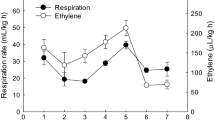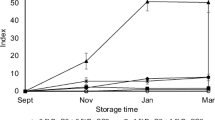Abstract
A study was undertaken to assess the effect of different storage temperatures on senescence and postharvest performance of isolated flowers of Ranunculus asiaticus L.. The main aim of the work was to develop a cost-effective storage protocol to reduce the postharvest losses and to bring out the transportation of cut flowers of R. Asiaticus. The flowers were subjected to two different storage treatments, dry storage and wet storage, and their postharvest performance was compared under laboratory conditions. For this purpose, the buds were harvested at 8:00 AM at loose bud stage (Stage II of flower development). The harvested buds were cut to a uniform size of 15 cm and processed for dry or wet storage. For dry storage, the buds were packed after wrapping them in moistened filter papers and kept at 5°C and 10°C. For wet storage, the buds were held in distilled water in separate glass beakers kept at 5°C and 10°C, respectively. A separate set of buds each for dry and wet storage was kept at room temperature (15±2)°C. After 72 h storage, the buds were kept at room temperature in distilled water. The average life of an individual flower that opened fully was about 4–5 days. The buds kept under wet storage at 5°C and 10°C for 72 h maintained their premature status, while the buds held at room temperature for 72 h generally bloomed. All the buds stored dry maintained their premature status irrespective of storage temperature. Storage of buds for 72 h at 5°C, followed by transferring to distilled water improved the longevity by about 5 to 6 days. Cold storage treatment before transferring to holding solution improved floral diameter, membrane integrity besides maintaining higher fresh and dry mass of flowers, sugar content, soluble proteins, and phenols. Our results suggested that wet and dry storage of premature buds of R. asiaticus for 72 h at 5°C, followed by placing them in distilled water, improved the cut flower longevity and can be used as effective postharvest storage treatments for this beautiful cut flower.
Similar content being viewed by others
References
Ahn G Y, Park J C (1996). Effect of harvest time on quality preservation of cut rose ‘Mary de Vor’. Journal of Korean Society for Horticultural Science, 37: 603–606
Bunya-atichart K, Ketsa S, Van Doorn W G (2004). Postharvest physiology of curcuma alismatifolia flowers. Postharvest Biology and Technology, 34(2): 219–226
Celikel F G, Reid M S (2002). Storage temperature affects the quality of cut flowers from the Asteraceae. HortScience, 37(1): 148–150
Cevallos J C, Reid M S (2001). Effect of dry and wet storage at different temperatures on the vase life of cut flowers. HortTechnology, 11:199–202
Gul F, Tahir I (2009). Effect of cool and wet storage on postharvest performance of Nerine sarniensis cv. Red scapes. Acta Horticulturae, 847: 345–352
Gul F, Tahir I, Sultan S M (2007). Effect of storage temperature on postharvest performance of Amaryllis belladonna L. cv. Rosea scapes. Journal of Plant Biology, 34: 43–47
Ichimura K, Kojima K, Goto R (1999). Effects of temperature, 8-hydroxyquinoline sulphate and sucrose on the vase life of cut rose flowers. Postharvest Biology and Technology, 15(1): 33–40
Jones M L (2008). Ethylene signaling is required for pollinationaccelerated corolla senescence in Petunias. Plant Science, 175(1–2): 190–196
Joyce D C, Meara S A, Hetherington S E, Jones P (2000). Effects of cold storage on cut Grevillea ’sylvia’ inflorescences. Postharvest Biology and Technology, 18(1): 49–56
Lee A, Suh J (1996). Effect of harvest stage, pre- and post-harvest treatment on longevity of cut Lilium flowers. Acta Horticulturae, 414:287–294
Leonard R T, Nell T A, Suzuki A, Barrett J E, Clark D G (2001). Evaluation of long term transport of Colombian grown cut roses. Acta Horticulturae, 543: 285–291
Lowry O H, Rosebrough N J, Farr A L, Randall R J (1951). Protein measurement with the Folin phenol reagent. Journal of Biological Chemistry, 193(1): 265–275
Mwangi M, Chatterjee S R, Bhattacharjee S K (2003). Changes in the biochemical constituents of “Golden gate” cut rose petals as affected by precooling with ice cold water spray, pulsing and packaging. Journal of Plant Biology, 30: 95–97
Nelson N (1944). Photometric adaptation of Somogy’s method for the determination of glucose. J Biol Chem, 153: 375–380
Nowak J, Rudnicki R M (1990). Storage. In: Nowak J, Rudnicki R M, eds. Postharvest Handling and Storage of Cut Flowers, Florist Greens and Potted Plants. Portland: Timber Press, 67–86
Page T, Griffiths G, Buchanan-Wollaston V (2001). Molecular and biochemical characterization of postharvest senescence in broccoli. Plant Physiol, 125(2): 718–727
Redman P B, Dole J M, Maness N O, Anderson J A (2002). Post harvest handling of nine specialty cut flower species. Scientia Horticulturae, 92(3–4): 293–303
Shahri W, Tahir I, Gul F (2009). Effect of dry and wet storage at cool temperatures on postharvest performance of Consolida ajacis cv. Violet blue spikes. Journal of Plant Biology, 36: 5–9
Swain T, Hillis W E (1959). The phenolic constituents of Prunus domestica I.—the quantitative analysis of phenolic constituents. Journal of the Science of Food and Agriculture, 10(1): 63–68
Taverner E, Letham D S, Wang J, Cornish E, Wilkins D A (1999). Influence of ethylene on cytokinin metabolism in relation to Petunia corolla senescence. Phytochemistry, 51(3): 341–347
van der Meulen-Muisers J JM, van Oeveren J C (1997). Influence of bulb stock origin, inflorescence harvest stage and postharvest evaluation conditions on cut flower longevity of Asiatic hybrid lilies. Journal of the American Society for Horticultural Science, 122: 368–372
van Doorn W G, de Witte Y (1991). Effect of dry storage on bacterial counts in stems of cut rose flowers. HortScience, 26: 1521–1522
van Doorn W G, Woltering E J (2005). Many ways to exit? Cell death categories in plants. Trends in Plant Science, 10(3): 117–122
Wagstaff C, Chanasut U, Harren F J M, Laarhoven L J, Thomas B, Rogers H J, Stead A D (2005). Ethylene and flower longevity in Alstroemeria: relationship between tepal senescence, abscission and ethylene biosynthesis. Journal of Experimental Botany, 56(413): 1007–1016
Zhou Y, Wang C Y, Cheng Z W (2008). Effect of exogenous ethylene and ethylene inhibitor on longevity and petal senescence of sweet Osmanthus. Acta Horticulturae, 768: 487–493
Author information
Authors and Affiliations
Corresponding author
About this article
Cite this article
Shahri, W., Tahir, I., Islam, S.T. et al. Effect of dry and wet storage at cool temperatures on the post-harvest performance of Ranunculus asiaticus L. flowers. Front. Agric. China 5, 382–387 (2011). https://doi.org/10.1007/s11703-011-1118-y
Received:
Accepted:
Published:
Issue Date:
DOI: https://doi.org/10.1007/s11703-011-1118-y




